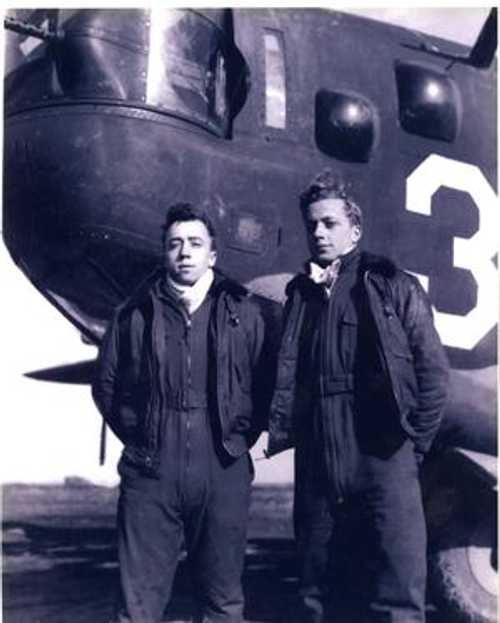
US Army Air Force
Harry and Roy Humrighouse
http://www.cantonrep.com/topstories/x470403700/WWII-Then-and-Now-Harry-Humrighouse-served-with-his-brother-Roy-on-a-B-24-bomber?img=3
Harry Humrighouse (left) and his twin brother, Roy Humrighouse, are pictured during World War II beside a B-24 Liberator bomber. The brothers served in the Army Air Corps during the war on the same B-24 bomber crew. When Harry Humrighouse enlisted in the Army in March 1943, he wanted to serve with his twin brother Roy, who was working with him at Westinghouse Electric Co. in Canton before the war. But, Harry was assigned to the Army Air Corps and his sibling was sent to a ground combat unit. “We wanted to be put together; we both asked,” Humrighouse said, who with his brother was originally from Uhrichsville. “Then our mother wrote to the adjutant general (in Washington) and asked for us to serve together. My brother was all set to go overseas, but he was transferred to the Army Air Corps.” That’s how the Humrighouse brothers wound up on the same B-23 Liberator bomber, flying missions out of Italy for the 484th Bomb Group. Roy was a nose turret gunner and Harry was a gunner in the ball turret. “I don’t know what she wrote,” said Harry Humrighouse. “He was just taken out of the infantry and sent to (the Army Air Corps base in) Idaho.” FLYING MISSIONS Humrighouse served “in the latter part of the war,” he said. “We went over in October of 1944 and came back in May of 1945, when the war (in Europe) was over.” On each of the 25 missions that Humrighouse flew, he was lowered and raised — his parachute in a backpack — in the ball turret beneath the fuselage of his plane. From his position, sitting almost in a fetal position, Humrighouse could see the bombs drop. “We got hit by flak a few times,” he said. “There were a lot of that little stuff flying around up there.” The view was frightening — it allowed Humrighouse to see such things as two planes colliding — but the work Humrighouse did allowed him little time for fear. “I’d have to say you were concerned,” he said. “You saw what happened to other personnel. But, were you afraid? No.” Perhaps, the Humrighouse brothers’ safety was in part due to their proximity to men making flight history. The 484th was escorted by the fighter pilots known as the Tuskegee Airmen. These African-American pilots of the 332nd Fighter Group, originally barred from flying in combat because of their color — but who later had one of the best combat records during World War II — flew more than 300 missions with the bombers of the 15th Air Force. “They were always around us,” said Humrighouse. “And we were glad they were there. They gave us protection.” greetz,brummbar
1861 Views
10/15/2012
